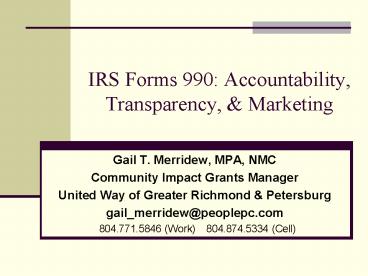IRS Forms 990: Accountability, Transparency, - PowerPoint PPT Presentation
1 / 12
Title:
IRS Forms 990: Accountability, Transparency,
Description:
IRS Media Job seekers Other nonprofits State regulators Watch ... General Information Analyst Report Board of Directors ... Strategic Planning Author: Gail T ... – PowerPoint PPT presentation
Number of Views:131
Avg rating:3.0/5.0
Title: IRS Forms 990: Accountability, Transparency,
1
IRS Forms 990 Accountability, Transparency,
Marketing
- Gail T. Merridew, MPA, NMC
- Community Impact Grants Manager
- United Way of Greater Richmond Petersburg
- gail_merridew_at_peoplepc.com
- 804.771.5846 (Work) 804.874.5334 (Cell)
2
Purpose of Form
- Used by tax-exempt organizations, Section 527
political organizations, and nonexempt charitable
trusts to provide information to the IRS (as
required by Section 6033) - Available for public inspection (Section 6104)
- Primary or sole source of information about
specified organizations programs and
accomplishments - From IRS Instructions for Form 990 and Form 990-EZ
3
Three Guiding Principles
- Enhancing transparency to provide the IRS and the
public a realistic picture of the organization
and a reasonable basis for comparison to other
organizations. - Promoting compliance and accountability by
accurately reflecting the organizations
operations so the IRS may efficiently assess the
risk of noncompliance. - Minimizing the burden for filing multiple
documents with multiple entities.
4
Filing Requirements
- All 501(c)(3) tax exempt organizations need to
make an annual filing. Generally - 990-N (e-postcard) for organizations with annual
gross receipts less than 50,000 - Form 990-EZ for organizations with annual gross
receipts less than 200,000 and total assets less
than 500,000 at the end of the year - Form 990 for organizations with gross receipts
greater than or equal to 200,000 or total assets
greater than or equal to 500,000 at the end of
the year
5
Filing Requirements
- Failure to file for 3 consecutive years will
result in the automatic revocation of your tax
exempt status. - Tax penalties exist for failure to make timely
filings. - (A penalty of 20/day, not to exceed 10,000 or
5 of total revenue, may be charged. For
organizations with 1 Million or more in total
revenue, a penalty of 100/day, not to exceed
50,000, may be charged.)
6
Accounting Periods
- Calendar Year January 1 December 31
- Fiscal Year 365/366 day period beginning with
the first day of one month and ending with the
last day of the previous month (e.g. July 1
through June 30) - will often coincide with the
organizations natural operating or funding
cycle, where one exists. - Short period an accounting period less than 12
months (may be used to move from one reporting
period to another).
7
When to File
- The 15th day of the 5th month after the end of
the organizations accounting period - For calendar year preparers 5/15
- For fiscal years ending 6/30 11/15
- For fiscal years ending 9/30 2/15
- Automatic extensions of 3 months may be requested
with Form 8868 however, reasonable cause for the
additional time requested must be provided for
this or additional extensions.
8
Who is looking at your Form 990?
- IRS
- Media
- Job seekers
- Other nonprofits
- State regulators
- Watch dog groups
- Potential board members
- Potential donors / funders
- Large foundations often have staff devoted to
990 analysis
9
GuideStar (www.guidestar.org)
- Using GuideStar
- How to Find What Youre Looking for in GuideStar
- Search Results
- General Information Analyst Report
- Board of Directors Financial Data
- Mission and Programs (Premium Members or )
- Goals and Results
- Form 990 and EDOCs
10
Documents
- Funders often request one or more of the
following - IRS tax determination letter
- IRS Form(s) 990
- Annual Report(s)
- Audited Financial Statement(s)
- IRS Form 1023
- Other independent financial review or compilation
(smaller agencies) - Note All of these can be uploaded to GuideStar!
11
Common questions
- Tracking non-cash donations?
- Tracking volunteer hours?
- Performing comparables checks for salaries?
- Guidelines for conflict of interest and other
governance issues? - Separating program, management general, and
fundraising expenses? - Temporary versus permanently restricted funds?
12
About the Presenter
Having worked in the nonprofit and governmental
sectors since 1997, Gail Merridew currently works
as Community Impact Grants Manager for United Way
of Greater Richmond Petersburg. Gail has taught
the Form 990 class for Nonprofit Learning Point
since 2005. As a staff member who is called upon
to review grant applications, audited financial
statements and related Forms 990 for potential
partner agencies, Gail is very aware of the
impact that these documents can have when funders
make grant award decisions.































